Soil Geochemical Mapping of the Sal Island (Cape Verde): Ecological and Human Health Risk Assessment
Abstract
1. Introduction
2. Cape Verde Archipelago and Sal Island
| Geological Formation | Cropping-Out Regions | Rock Type | Lithology | Primary Minerals |
|---|---|---|---|---|
| Ancient Eruptive Complex (CA) | Central western | Submarine lava flows, breccia; dykes and plutonic masses; and intercalated sedimentary units | Basalts and occasional dolomitic limestone | Olivine, pyroxene, feldspar, magnetite, ilmenite, sanidine, nepheline, leucite, dolomite, and phyllosilicates |
| Principal Eruptive Formation (EP) | Continuous strip in the central to southern portion | Submarine (lower series) and subaerial (upper series) extrusive rocks | Alkali basalt and nephelinites | Olivine, pyroxene, alkaline feldspar, nepheline, leucite, carbonates, oxides, and apatite |
| Ponta do Altar-Baleia Complex (PAB) and intercalated sedimentary units | Mostly northern and north-western | Subaerial (lower portion) and submarine (upper) lava flows; volcanic feeding vents; and nearshore and shallow marine deposits | Alkali basalt and nephelinites; Conglomerates and calcarenites | Olivine, pyroxenes, alkaline feldspar, nepheline, leucite, carbonates, oxides, apatite, quartz, and phyllosilicates |
| Serra Negra Formation (SN) | Restricted south-eastern areas | Lava delta | Alkali basalt and nephelinites | Olivine, pyroxenes, alkaline feldspar, nepheline, leucite, carbonates, oxides, and apatite |
| Monte Grande-Pedra Lume Formation (MG-PL) | Mostly northern and north-eastern | Subaerial lavas and pyroclastic rocks | Alkali basalt and nephelinites | Olivine, pyroxenes, alkaline feldspar, nepheline, leucite, carbonates, oxides, and apatite |
| Quaternary deposits | Multiple areas in the periphery and occasional central parts | Diverse sedimentary deposits, including terraces, fossil dunes, etc. | Conglomerate, sandstone, calcarenite, and limestone | Quartz, feldspar, carbonates, and phyllosilicates |
3. Methodology
3.1. Field Sampling, Sample Treatment, and Chemical Analysis
3.2. Statistical Analysis
3.3. Spatial Distribution of Chemical Elements
4. Results and Discussion
4.1. Univariate Statistics and Maps of Baseline Value Fields
4.2. Multivariate Statistical Analysis
- -
- CP1 explains 39% of the total variance. Elements that tend to be abundant in silicate rocks, such as Fe, Mn, Co, Sc, Zn, Al, Ni, La, V, and Ti, are plotted in opposition to Ca and Sr, typical of carbonate rocks. This suggests that CP1 reflects the silicate versus carbonate natures of soil parent rocks.
- -
- CP2 explains 19% of the total variance and positively associates Tl, As, Pb, and Sb, possibly reflecting the presence of anthropogenic sources. However, because these elements are frequently associated with saline environments, which are common on the island, they can also be considered to have a geogenic origin linked to the presence of evaporites.
- -
- CP3 explains 10% of the total variance, yielding relatively high loadings of U, La, and Ba. As these elements tend to be more abundant in phonolites and other feldspathoid-rich rocks than in basalts, it is probable that this reflects the nature of the most common lithological suites (basaltic vs. nephelinic) observed in the volcanic units of Sal Island.
4.3. Ecologic Risks
4.4. Estimation of Health Hazards Due to PTE Exposure
4.4.1. Non-Carcinogenic Risk
4.4.2. Carcinogenic Risks
5. Conclusions
Author Contributions
Funding
Data Availability Statement
Acknowledgments
Conflicts of Interest
References
- Steffen, W.; Grinevald, J.; Crutzen, P.; McNeill, J. The Anthropocene: Conceptual and historical perspectives. Philos. Trans. R. Soc. A Math. Phys. Eng. Sci. 2011, 369, 842–867. [Google Scholar] [CrossRef]
- Lewis, S.L.; Maslin, M.A. Defining the anthropocene. Nature 2015, 519, 171–180. [Google Scholar] [CrossRef]
- Salminen, R.; Chekushin, V.; Tenhola, M.; Gregorauskiene, V.; Bogatyrev, I.; Kashulina, G.; Fedotova, E.; Niskavaara, H.; Polischuok, A.; Glavatskikh, S.P.; et al. Geochemical Atlas of Eastern Barents Region; Gulf Professional Publishing: Houston, TX, USA, 2005. [Google Scholar]
- De Vivo, B.; Lima, A.; Bove, M.A.; Albanese, S.; Cicchella, D.; Sabatini, G.; Di Lella, L.A.; Protano, G.; Riccobono, F.; Frizzo, P.; et al. Environmental geochemical maps of Italy from the FOREGS database. Geochem. Explor. Environ. Anal. 2008, 8, 267–277. [Google Scholar] [CrossRef]
- Halamić, J.; Peh, Z.; Miko, S.; Galović, L.; Šorša, A. Geochemical atlas of Croatia: Environmental implications and geodynamical thread. J. Geochem. Explor. 2012, 115, 36–46. [Google Scholar] [CrossRef]
- Bravo, S.; García-Ordiales, E.; García-Navarro, F.J.; Amorós, J.Á.; Pérez-de-Los-Reyes, C.; Jiménez-Ballesta, R.; Esbrí, J.M.; García-Noguero, E.M.; Higueras, P. Geochemical distribution of major and trace elements in agricultural soils of Castilla-La Mancha (central Spain): Finding criteria for baselines and delimiting regional anomalies. Environ. Sci. Pollut. Res. 2019, 26, 3100–3114. [Google Scholar] [CrossRef]
- Cinelli, G.; Tollefsen, T.; Bossew, P.; Gruber, V.; Bogucarskis, K.; De Felice, L.; De Cort, M. Digital version of the European Atlas of natural radiation. J. Environ. Radioact. 2019, 196, 240–252. [Google Scholar] [CrossRef] [PubMed]
- De Caritat, P.; Cooper, M. A Continental-Scale Geochemical Atlas for Resource Exploration and Environmental Management: The National Geochemical Survey of Australia; The Geological Society of London: London, UK, 2016. [Google Scholar]
- Musgrove, M. The occurrence and distribution of strontium in US groundwater. Appl. Geochem. 2021, 126, 104867. [Google Scholar] [CrossRef]
- Smith, D.B.; Wang, X.; Reeder, S.; Demetriades, A. The IUGS/IAGC task group on global geochemical baselines. Earth Sci. Front. 2012, 19, 1–6. [Google Scholar]
- Zuzolo, D.; Cicchella, D.; Demetriades, A.; Birke, M.; Albanese, S.; Dinelli, E.; Lima, A.; Valera, P.; De Vivo, B. Arsenic: Geochemical distribution and age-related health risk in Italy. Environ. Res. 2020, 182, 109076. [Google Scholar] [CrossRef] [PubMed]
- Cabral Pinto, M.M.; Marinho-Reis, A.P.; Almeida, A.; Ordens, C.M.; Silva, M.M.; Freitas, S.; Simões, M.R.; Moreira, P.I.; Dinis, P.A.; Diniz, M.L.; et al. Human predisposition to cognitive impairment and its relation with environmental exposure to potentially toxic elements. Environ. Geochem. Health 2018, 40, 1767–1784. [Google Scholar] [CrossRef] [PubMed]
- Cabral Pinto, M.M.; Ordens, C.M.; Condesso de Melo, M.T.; Inácio, M.; Almeida, A.; Pinto, E.; Ferreira da Silva, E.A. An inter-disciplinary approach to evaluate human health risks due to long-term exposure to contaminated groundwater near a chemical complex. Expo. Health 2020, 12, 199–214. [Google Scholar] [CrossRef]
- Cabral-Pinto, M.M.; Saha, N.; Ordens, C.M.; Pitta-Gros, D.; Carlos, G.; Dinis, P.; Marques, R.; Prudêncio, I.; Rocha, F.; Ferreira da Silva, E.A. Integrated Geochemical and Mineralogical Investigation of Soil from the Volcanic Fogo Island (Cape Verde): Implications for Ecological and Probabilistic Human Health Risks. Expo. Health 2023, 15, 1–17. [Google Scholar] [CrossRef]
- Darnley, A.G.; Bjorklund, A.; Bolviken, B.; Gustavsson, N.; Koval, P.V.; Uk, J.P.; Steenfelt, A.; Tauchid, M.; Xuejing, X. A Global Geochemical Database. Recommendations for International Geochemical Mapping; Final Report of IGCP Project; UNESCO Publishing: Paris, France, 1995; Volume 259. [Google Scholar]
- Diniz, A.C.; de Matos, G.C. Map of Agro-Ecological Zonation and Vegetation in Cape Verde; V-Sal Island: Sal, Cape Verde, 1993. [Google Scholar]
- Lee, D.B.; Kim, Y.N.; Sonn, Y.K.; Kim, K.H. Comparison of Soil Taxonomy (2022) and WRB (2022) Systems for classifying Paddy Soils with different drainage grades in South Korea. Land 2023, 12, 1204. [Google Scholar] [CrossRef]
- Holm, P.; Wilson, J.R.; Christensen, B.; Hansen, L.; Hansen, S.; Khein, K.M.; Mortensen, A.; Pedersen, R.; Plesner, S.; Runge, M. Sampling the Cape Verde Plume: Evolution of Melt Compositions on Santo Antão, Cape Verde Islands. J. Petrol. 2008, 47, 145–189. [Google Scholar] [CrossRef]
- Ramalho, R.S.; Helffrich, G.; Cosca, M.; Vance, D.; Hoffmann, D.; Schmidt, D.N. Vertical movements of ocean island volcanoes: Insights from a stationary plate environment. Mar. Geol. 2010, 275, 84–95. [Google Scholar] [CrossRef]
- Ubaldo, M.L.; Silva, L.C.; Torres, P.C. Geological and Micropaleontological Contribution towards the Knowledge of the “Old Eruptive Complex” of Sal Island, Cape Verde Archipelago. 1991. Available online: https://www.researchgate.net/figure/Geological-map-of-Sal-Island-showing-the-stratigraphic-units-after-TORRES-et-al_fig3_215579234 (accessed on 30 May 2024).
- Torres, P.; Silva, L.; Serralheiro, A.; Mendes, M.; Macedo, J.; Gomes, A. Geologia da Ilha do Sal, Comunicações do Instituto de Investigação Científica Tropical. 2002. Available online: https://repositorio.usp.br/directbitstream/324f83bd-aad7-4130-831b-2f5bf3b13db2/2433496.pdf (accessed on 30 May 2024).
- Torres, P.; Silva, L.D.; Munhá, J.; Caldeira, R.; Mata, J.; Tassinari, C.C.G. Petrology and geochemistry of lavas from Sal Island: Implications for the variability of the Cape Verde magmatism. Comun. Geol. 2010, 97, 35–61. [Google Scholar]
- Zazo, C.; Goy, J.; Dabrio, C.; Soler, V.; Hillaire-Marcel, C.; Ghaleb, B.; González-Delgado, J.; Bardají, T.; Cabero, A. Quaternary marine terraces on Sal Island (Cape Verde archipelago). Quat. Sci. Rev. 2007, 26, 876–893. [Google Scholar] [CrossRef]
- Jolliffe, I.T. Principal Component Analysis for Special Types of Data; Springer: New York, NY, USA, 2003; pp. 338–372. [Google Scholar]
- Canadian Legislation: Ministry of the Environment April 15, 2011. Soil, Ground Water and Sediment Standards for Use under Part XV.1 of the Environmental Protection Act. Available online: https://www.ontario.ca/page/soil-ground-water-and-sediment-standards-use-under-part-xv1-environmental-protection-act (accessed on 30 May 2024).
- Dutch Guidelines: Ministry of Housing, Spatial Planning and the Environment (VROM). Circular on Target Values and Intervention Values for Soil Remediation. The Netherlands Government Gazette, No. 39, Ministry of Housing, Spatial Planning and Environment, Directorate General for Environmental Protection, Department of Soil Protection. Available online: http://www.esdat.net/Environmental%20Standards/Dutch/annexS_I2000Dutch%20Environmental%20Standards.pdf (accessed on 30 May 2024).
- Ji, J.; Zhao, Y.; Zhang, W.; Gu, K.; Li, W. Quantitative assessment of biocrust distribution patterns using landscape indices benefits the study of their soil conservation functions. Geoderma 2023, 429, 116257. [Google Scholar] [CrossRef]
- Cabral Pinto, M.M.; Ferreira da Silva, E.A.; Silva, M.M.; Melo-Gonçalves, P.; Candeias, C. Environmental risk assessment based on high-resolution spatial maps of potentially toxic elements sampled on soil of Santiago, Cape Verde. Geosciences 2014, 4, 297–315. [Google Scholar] [CrossRef]
- Cabral-Pinto, M.M.S.; Silva, E.F.; Silva, M.M.V.G.; Melo-Gonçalves, P. Heavy metals of Santiago Island (Cape Verde) top soils: Estimated background value maps and environmental risk assessment. J. Afr. Earth Sci. 2015, 101, 162–176. [Google Scholar] [CrossRef]
- Cabral Pinto, M.M.; Silva, M.M.; Ferreira da Silva, E.A.; Marinho-Reis, A.P. The cancer and non-cancer risk of Santiago Island (Cape Verde) population due to potential toxic elements exposure from soils. Geosciences 2017, 7, 78. [Google Scholar] [CrossRef]
- Cabral Pinto, M.M.; Marinho-Reis, P.; Almeida, A.; Pinto, E.; Neves, O.; Inácio, M.; Gerardo, B.; Freitas, S.; Simões, M.R.; Dinis, P.A.; et al. Links between cognitive status and trace element levels in hair for an environmentally exposed population: A case study in the surroundings of the estarreja industrial area. Int. J. Environ. Res. Public Health 2019, 16, 4560. [Google Scholar] [CrossRef] [PubMed]
- Nayeri, S.; Dehghanian, Z.; Lajayer, B.A.; Thomson, A.; Astatkie, T.; Price, G.W. CRISPR/Cas9-Mediated genetically edited ornamental and aromatic plants: A promising technology in phytoremediation of heavy metals. J. Clean. Prod. 2023, 428, 139512. [Google Scholar] [CrossRef]
- Håkanson, L. An ecological risk index for aquatic pollution control. A sedimentological approach. Water Res. 1980, 14, 975–1001. [Google Scholar] [CrossRef]
- Maanan, M.; Saddik, M.; Maanan, M.; Chaibi, M.; Assobhei, O.; Zourarah, B. Environmental and ecological risk assessment of heavy metals in soil of Nador lagoon, Morocco. Ecol. Indic. 2015, 48, 616–626. [Google Scholar] [CrossRef]
- Kumar, A.; Suryadevara, N.; Hill, T.M.; Bezbradica, J.S.; Van Kaer, L.; Joyce, S. Natural killer T cells: An ecological evolutionary developmental biology perspective. Front. Immunol. 2017, 8, 1858. [Google Scholar] [CrossRef]
- Doležalová Weissmannová, H.; Mihočová, S.; Chovanec, P.; Pavlovský, J. Potential ecological risk and human health risk assessment of heavy metal pollution in industrial affected soils by coal mining and metallurgy in Ostrava, Czech Republic. Int. J. Environ. Res. Public Health 2019, 16, 4495. [Google Scholar] [CrossRef]
- USEPA (United States Environmental Protection Agency). Calculating Upper Confidence Limits for Exposure Point Concentrations at Hazardous Waste Sites; Office of Emergency and Remedial Response: Washington, DC, USA, 2002.
- USEPA (United States Environmental Protection Agency). Risk Assessment Guidance for Superfund: Volume III—Part A, Process for Conducting Probabilistic Risk Assessment; EPA 540-R-02-002; U.S. Environmental Protection Agency: Washington, DC, USA, 2001.
- USEPA (United States Environmental Protection Agency). Science Policy Council. Guidance on Cumulative Risk Assessment. Part 1; U.S. Environmental Protection Agency: Washington, DC, USA, 2001.
- De Miguel, E.; Iribarren, I.; Chacon, E.; Ordonez, A.; Charlesworth, S. Risk-based evaluation of the exposure of children to trace elements in playgrounds in Madrid (Spain). Chemosphere 2007, 66, 505–513. [Google Scholar] [CrossRef]
- Chabukdhara, M.; Nema, A.K. Heavy metals assessment in urban soil around industrial clusters in Ghaziabad, India: Probabilistic health risk approach. Ecotoxicol. Environ. Saf. 2013, 87, 57–64. [Google Scholar] [CrossRef]
- USEPA (United States Environmental Protection Agency). Toxicological Review of Inorganic Arsenic; U.S. Environmental Protection Agency: Washington, DC, USA, 2010.
- USEPA (United States Environmental Protection Agency). Exposure Factors Handbook 2011 Edition (Final). 2011. Available online: http://cfpub.epa.gov/ncea/risk/recordisplay.cfm?deid=236252 (accessed on 30 May 2024).
- IARC (International Agency for Research on Cancer). Chromium, Nickel and Welding. In Monographs on the Evaluation of Carcinogenic Risks to Humans; IARC: Lyon, France, 1990; Volume 49. [Google Scholar]

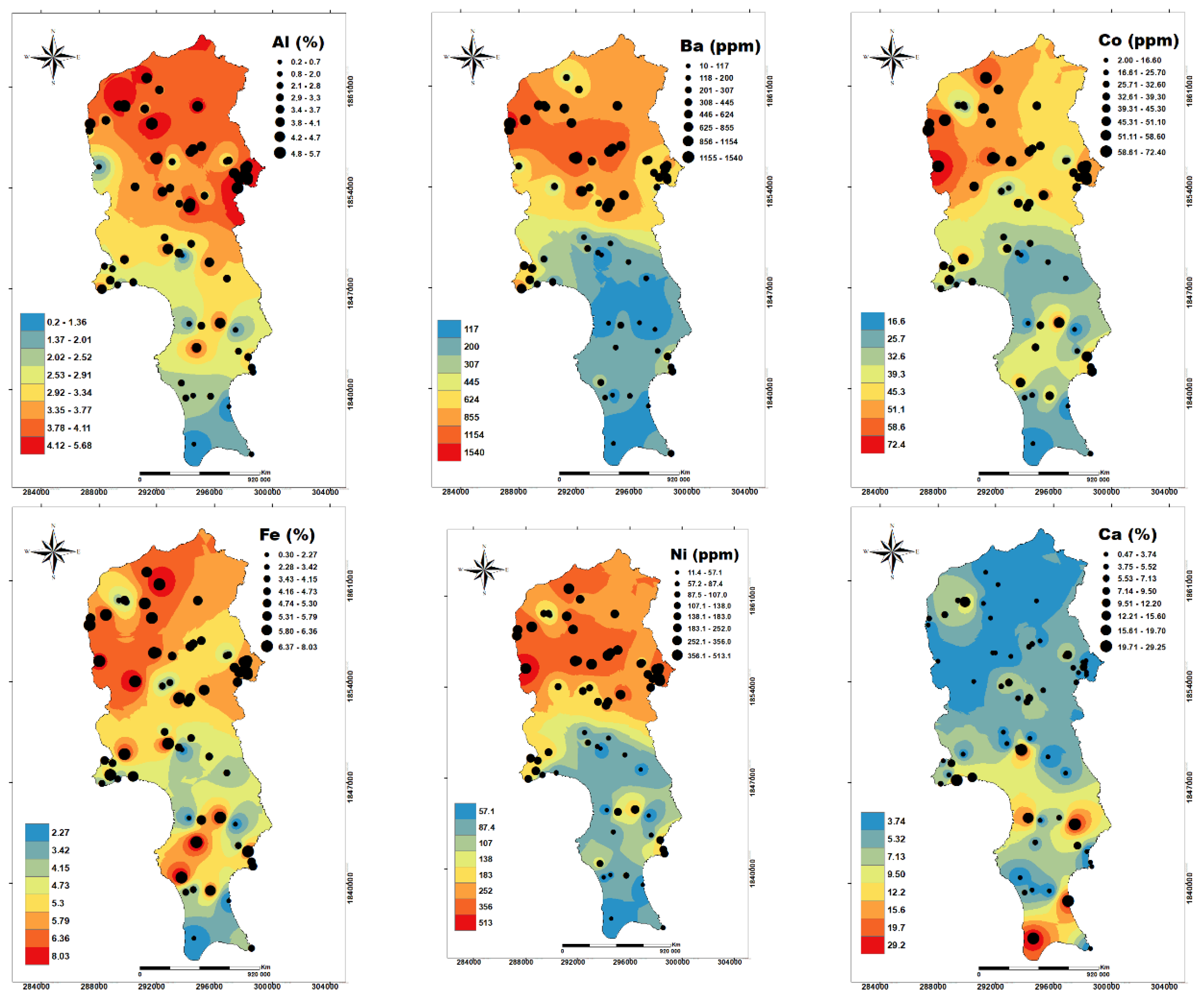

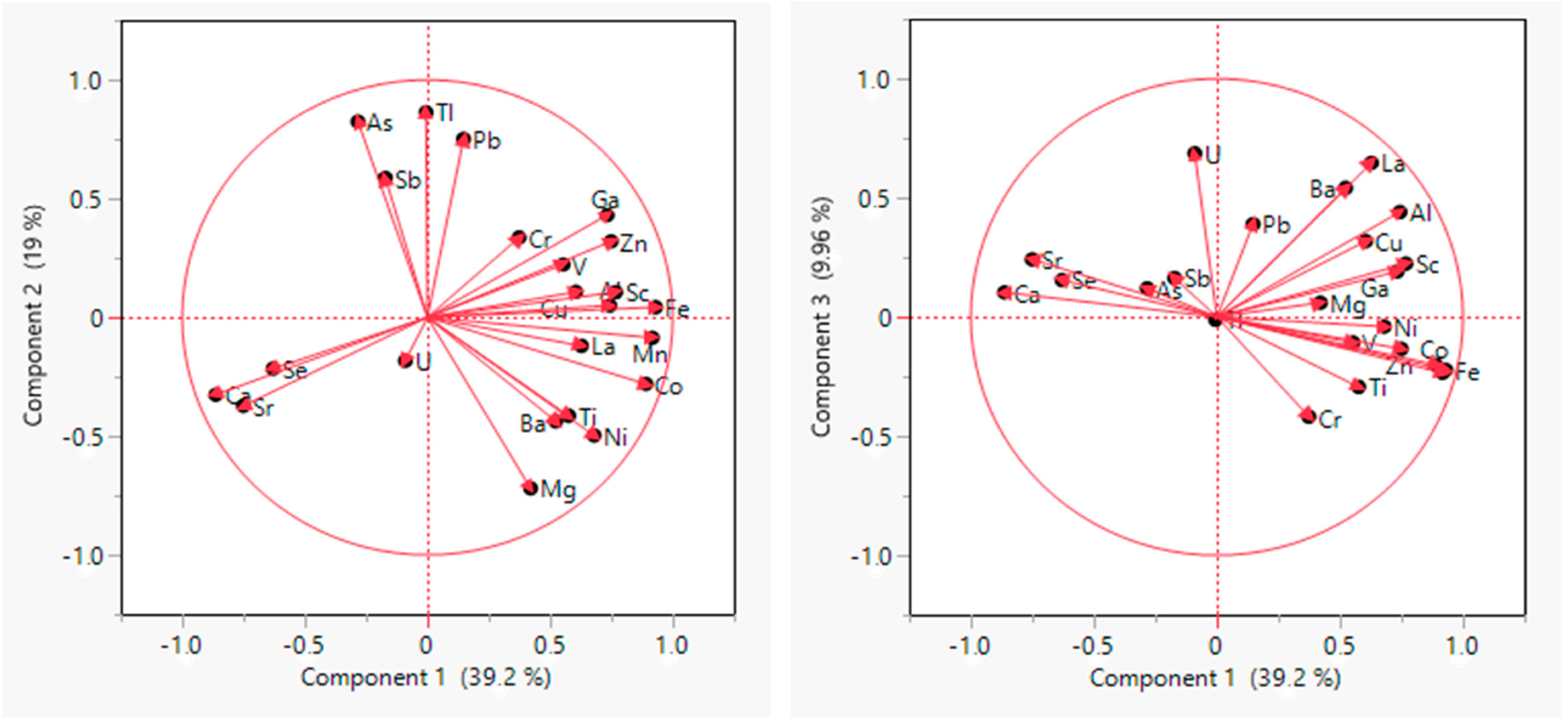
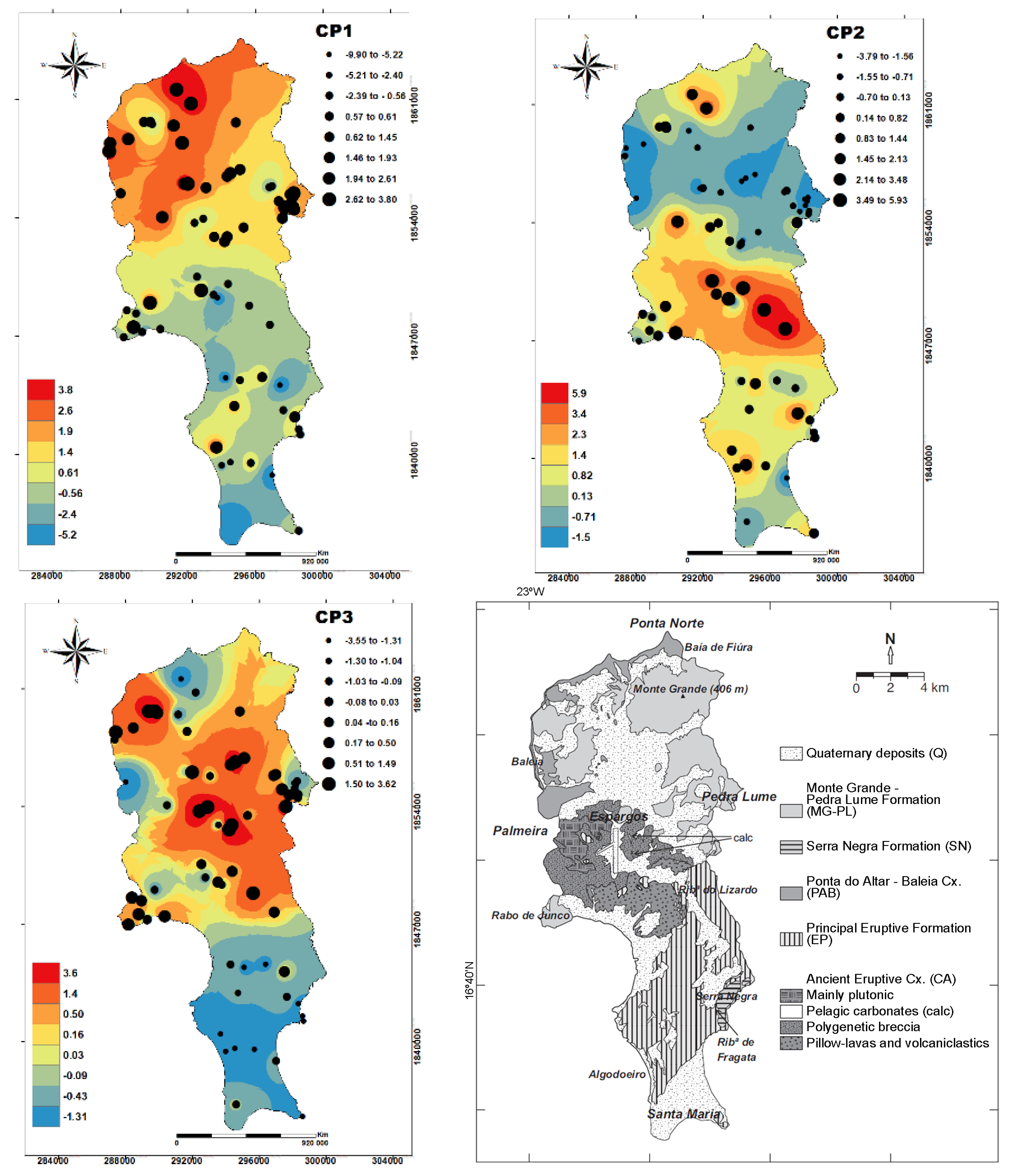
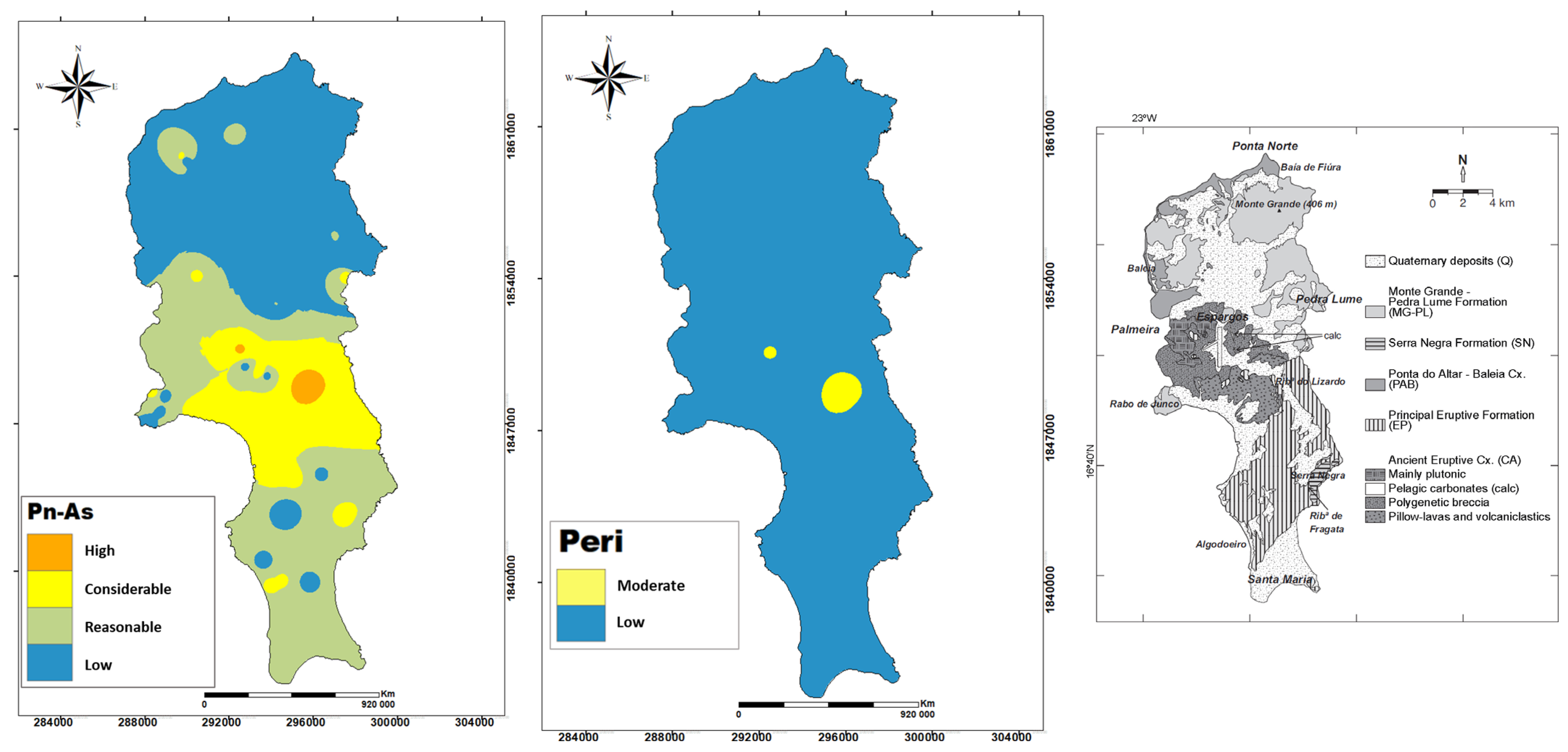
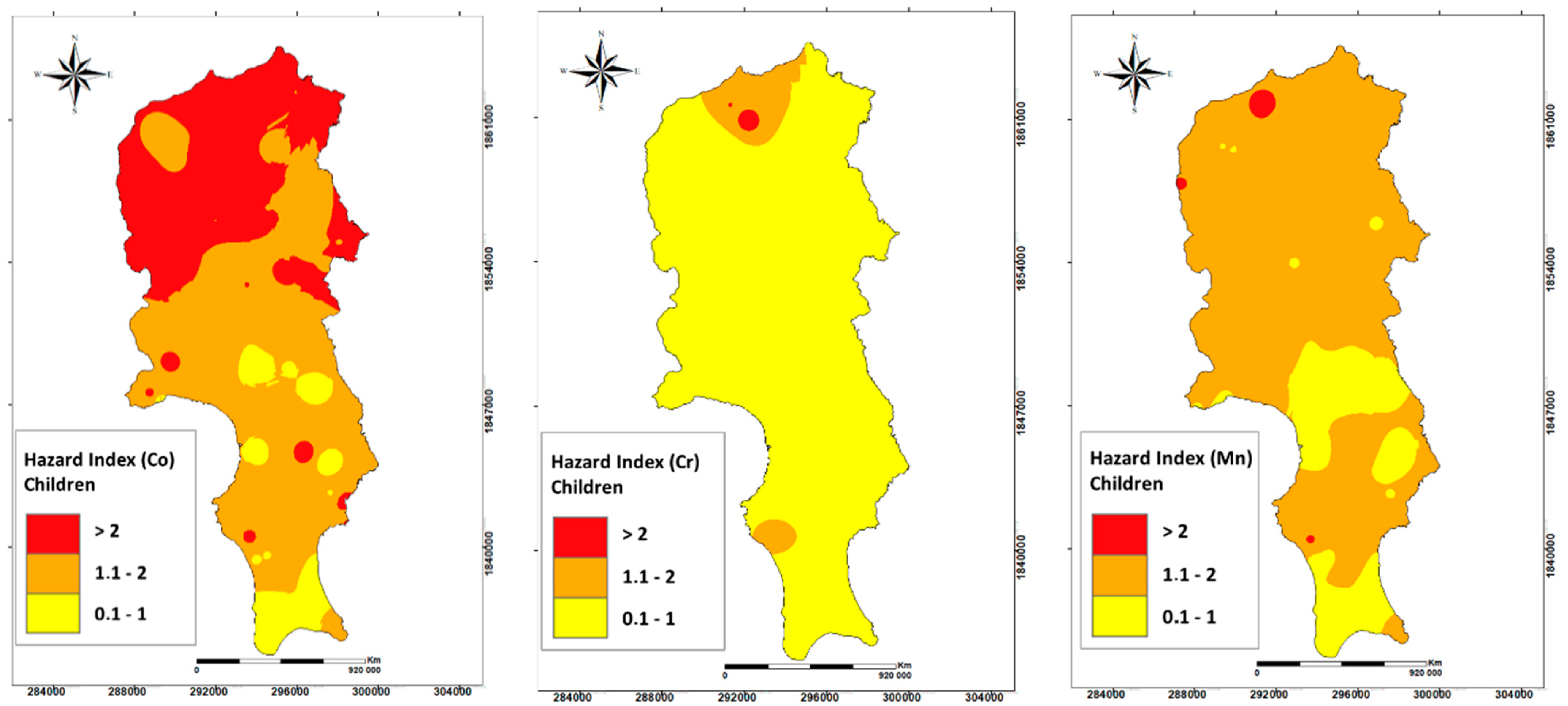
| Variable | Minimum | Median (BV) | Mean | Maximum | SD | CV | P5–P95 |
|---|---|---|---|---|---|---|---|
| Al | 0.2 | 3.4 | 3.3 | 5.7 | 1.1 | 0.3 | 1.3–5.0 |
| As | 0.1 | 1.5 | 2.4 | 12.3 | 2.4 | 1.0 | 0.3–6.7 |
| Ba | 10 | 352 | 437 | 1540 | 321 | 1 | 44–892 |
| Ca | 0.5 | 3.2 | 5.7 | 29.3 | 6.5 | 1.1 | 0.9–23 |
| Co | 2.0 | 40 | 37.8 | 72.4 | 16.1 | 0.4 | 30–62 |
| Cr | 14 | 82 | 104 | 570 | 91 | 0.9 | 30–214 |
| Cu | 2.1 | 47 | 46.3 | 140.7 | 22.6 | 0.5 | 9–77 |
| Fe | 0.3 | 5.3 | 5.0 | 8.0 | 1.8 | 0.4 | 1.2–7.3 |
| Ga | 0.5 | 9.9 | 9.6 | 16.4 | 3.3 | 0.3 | 3–14 |
| La | 1.6 | 28.7 | 30.4 | 69.3 | 13.9 | 0.5 | 8–55 |
| Mg | 0.8 | 3.3 | 3.9 | 10.0 | 2.2 | 0.6 | 1.4–8.5 |
| Mn | 78 | 1045 | 969 | 1671 | 360 | 0 | 252–1440 |
| Ni | 11 | 165 | 179 | 513 | 117 | 1 | 16–389 |
| P | 0.0 | 0.2 | 0.2 | 0.8 | 0.2 | 0.7 | 0.1–0.5 |
| Pb | 0.3 | 4.2 | 5.4 | 18.5 | 3.3 | 0.6 | 1.8–12 |
| Sb | 0.01 | 0.04 | 0.06 | 0.24 | 0.04 | 0.72 | 0.0–0.1 |
| Sc | 0.6 | 8.7 | 8.7 | 18.3 | 3.6 | 0.4 | 2–14 |
| Se | 0.1 | 0.3 | 0.4 | 1.2 | 0.2 | 0.5 | 0.1–0.7 |
| Sr | 58 | 303 | 382 | 1580 | 315 | 1 | 70–906 |
| Ti | 0.0 | 0.4 | 0.5 | 1.3 | 0.3 | 0.7 | 0.1–1.0 |
| Tl | 0.0 | 0.1 | 0.1 | 0.2 | 0.1 | 0.7 | 0.0–0.2 |
| U | 0.5 | 0.8 | 0.9 | 1.9 | 0.3 | 0.4 | 0.5–1.6 |
| V | 7 | 102 | 114 | 256 | 56 | 0.5 | 30–230 |
| Zn | 5.0 | 65.1 | 66.1 | 135.7 | 23.5 | 0.4 | 20–100 |
| Canadian Guidelines [25] | Dutch Guidelines [26] | ||
|---|---|---|---|
| BV | Soil Agriculture Property Uses | Soil Residential Property Uses | Target Values |
| As: 1.5 | 11 | 18 | 29 |
| Ba: 352 | 210 | 220 | 160 |
| Co: 40 | 19 | 21 | 9 |
| Cr: 82 | 114 | 67 | 100 |
| Cu: 47 | 62 | 92 | 36 |
| Ni: 165 | 37 | 82 | 36 |
| Pb: 4.2 | 45 | 120 | 85 |
| Sb: 0.04 | - | - | 3 |
| Se: 0.3 | 1.2 | 1.5 | - |
| U: 0.8 | 1.2 | 2.5 | |
| V: 102 | 86 | 86 | - |
| Tl: 0.1 | 1 | 1 | |
| Zn: 65 | 290 | 290 | 140 |
| Variable | PC1 | PC2 | PC3 |
|---|---|---|---|
| Cu | 0.6 | 0.1 | 0.3 |
| Pb | 0.1 | 0.8 | 0.4 |
| Zn | 0.7 | 0.3 | −0.1 |
| Sb | −0.2 | 0.6 | 0.2 |
| V | 0.6 | 0.2 | −0.1 |
| Ca | −0.9 | −0.3 | 0.1 |
| La | 0.6 | −0.1 | 0.6 |
| Cr | 0.4 | 0.3 | −0.4 |
| Mg | 0.4 | −0.7 | 0.1 |
| Ba | 0.5 | −0.4 | 0.5 |
| Ti | 0.6 | −0.4 | −0.3 |
| Al | 0.7 | 0.1 | 0.4 |
| Sc | 0.8 | 0.1 | 0.2 |
| Tl | 0.0 | 0.9 | 0.0 |
| Se | −0.6 | −0.2 | 0.2 |
| Ga | 0.7 | 0.4 | 0.2 |
| Ni | 0.7 | −0.5 | 0.0 |
| Co | 0.9 | −0.3 | −0.2 |
| Mn | 0.9 | −0.1 | −0.2 |
| Fe | 0.9 | 0.0 | −0.2 |
| As | −0.3 | 0.8 | 0.1 |
| U | −0.1 | −0.2 | 0.7 |
| Sr | −0.8 | −0.4 | 0.2 |
| Cancer Risk | ||
|---|---|---|
| Children | Adults | |
| Cr | 7 × 10−7 | 2 × 10−6 |
Disclaimer/Publisher’s Note: The statements, opinions and data contained in all publications are solely those of the individual author(s) and contributor(s) and not of MDPI and/or the editor(s). MDPI and/or the editor(s) disclaim responsibility for any injury to people or property resulting from any ideas, methods, instructions or products referred to in the content. |
© 2024 by the authors. Licensee MDPI, Basel, Switzerland. This article is an open access article distributed under the terms and conditions of the Creative Commons Attribution (CC BY) license (https://creativecommons.org/licenses/by/4.0/).
Share and Cite
Diniz, L.; Carlos, G.; Miranda, C.; Dinis, P.; Marques, R.; Rocha, F.T.; Silva, E.F.d.; Almeida, A.; Cabral Pinto, M. Soil Geochemical Mapping of the Sal Island (Cape Verde): Ecological and Human Health Risk Assessment. Land 2024, 13, 1139. https://doi.org/10.3390/land13081139
Diniz L, Carlos G, Miranda C, Dinis P, Marques R, Rocha FT, Silva EFd, Almeida A, Cabral Pinto M. Soil Geochemical Mapping of the Sal Island (Cape Verde): Ecological and Human Health Risk Assessment. Land. 2024; 13(8):1139. https://doi.org/10.3390/land13081139
Chicago/Turabian StyleDiniz, Luísa, Gelson Carlos, Carmelita Miranda, Pedro Dinis, Rosa Marques, Fernando Tavares Rocha, Eduardo Ferreira da Silva, Agostinho Almeida, and Marina Cabral Pinto. 2024. "Soil Geochemical Mapping of the Sal Island (Cape Verde): Ecological and Human Health Risk Assessment" Land 13, no. 8: 1139. https://doi.org/10.3390/land13081139
APA StyleDiniz, L., Carlos, G., Miranda, C., Dinis, P., Marques, R., Rocha, F. T., Silva, E. F. d., Almeida, A., & Cabral Pinto, M. (2024). Soil Geochemical Mapping of the Sal Island (Cape Verde): Ecological and Human Health Risk Assessment. Land, 13(8), 1139. https://doi.org/10.3390/land13081139











